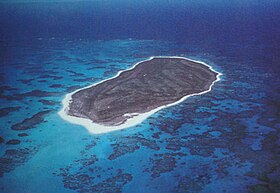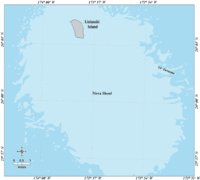Lisianski Island
Native name: Papa‘āpoho | |
|---|---|
 View of Lisianski from the air. | |
| Geography | |
| Location | Pacific Ocean |
| Coordinates | 26°03′51″N 173°57′57″W / 26.064031°N 173.965802°W |
| Archipelago | Northwestern Hawaiian Islands |
| Area | 384.425 acres (155.571 ha) |
| Length | 1.2 mi (1.9 km) |
| Width | 0.6 mi (1 km) |
| Coastline | 3.1 mi (5 km) |
| Administration | |
| State | Hawaii |
Lisianski Island (Hawaiian: Papa‘āpoho) is one of the Northwestern Hawaiian Islands, with a land area of 384.425 acres (155.571 ha) and a maximum elevation of 40 feet (12 m) above sea level. It is a low, flat sand and coral island about 905 nautical miles (1,041 mi; 1,676 km) northwest of Honolulu, Hawaii.[1] The island is surrounded by reefs and shoals, including the extensive Neva Shoals. Access to the island is possible only by helicopter or by boat via a narrow sandy inlet on the southeastern side of the island.
Administration
Politically, Lisianski Island is part of the
Geology and topography
Lisianski Island is made of
History
Lisianski Island is named after Yuri Lisyansky, a Russian Imperial explorer and an officer in the Imperial Russian Navy. Lisyansky was the commanding officer of the Russian-American Company's merchant sloop Neva, which was on an exploration mission as part of the first Russian circumnavigation of the world when she ran aground on the island in 1805. Lisyansky reported the island to be of little interest, except insofar as its surrounding reefs and shoals posed a threat to passing vessels.
King
After the
When Hawaii became a U.S. state in August 1959, Lisianski Island became part of the new State of Hawaii. On June 15, 2006, it was included in the Papahānaumokuākea Marine National Monument.[5]
Neva Shoals

Neva Shoals is a shallow


See also
- List of volcanoes in the Hawaiian – Emperor seamount chain
- List of islands
- Desert island
Bibliography
- Lisianski Island: Block 1014, Census Tract 114.98, Honolulu County, Hawaii, United States Census Bureau.
- M. Rauzon, Isles of Refuge: Wildlife and History of the Northwestern Hawaiian Islands, University of Hawaii Press, Honolulu: 2001.
References
- ^ a b "Lisianski Island and Neva Shoals" Archived 2006-09-29 at the Wayback Machine National Oceanic and Atmospheric Administration. Retrieved 12-22-2011.
- ^ Bryan, p. 10.
- ISBN 0-8248-0832-0.
- ^ "NWHI: About: Lisianski Island" Archived 2004-03-18 at the Wayback Machine Northwestern Hawaiian Islands Multi-Agency Education Project. Retrieved October 12, 2011
- ^ "U.S. Fish & Wildlife Service Hawaiian Islands National Wildlife Refuge: About the Refuge". Archived from the original on 2021-10-22. Retrieved 2021-10-22.
- ^ a b "Lisianski Island" Archived 2004-03-18 at the Wayback Machine, a University of Hawai'i webpage


